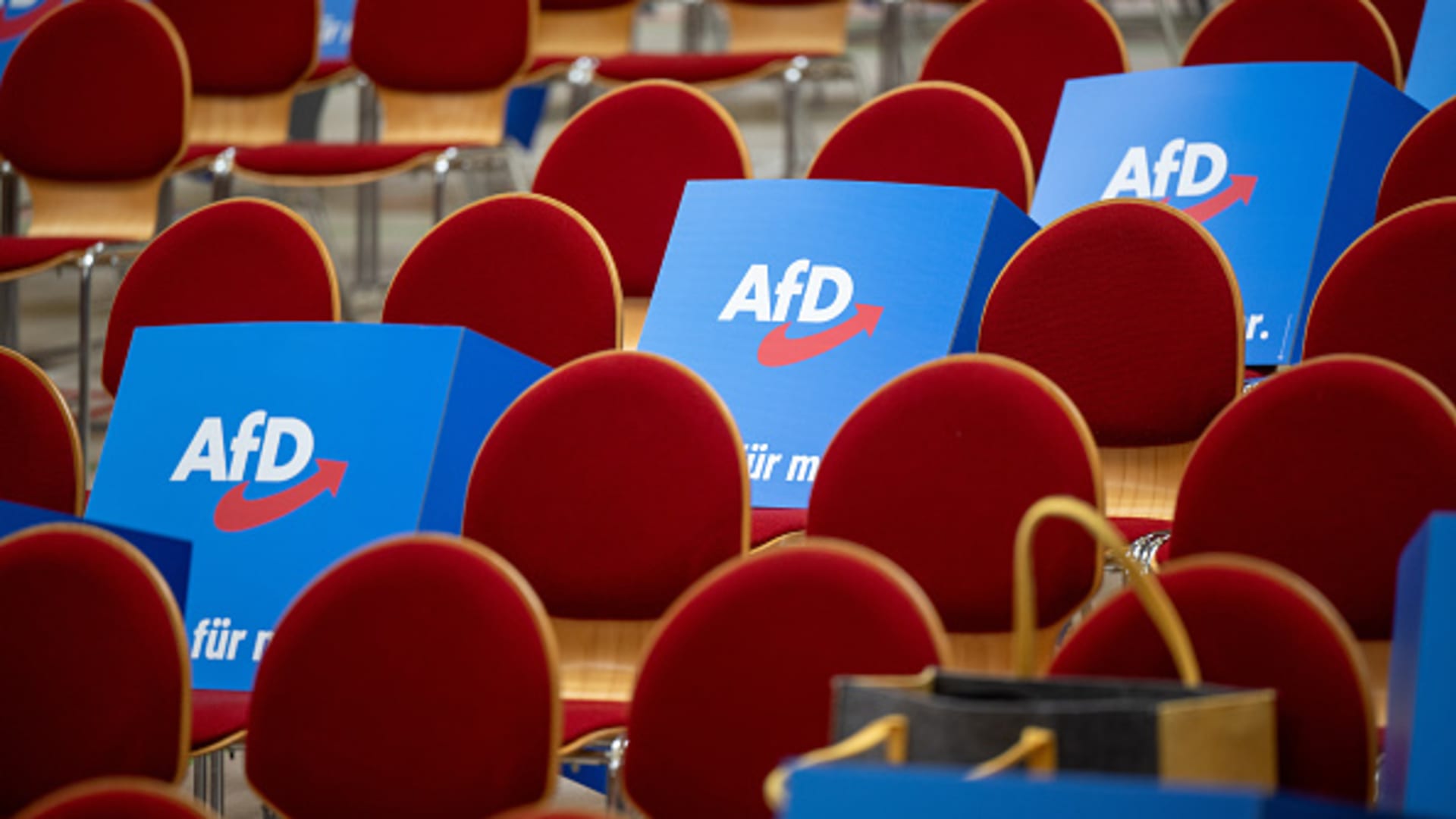
Cardboard stands with the AfD logo lie on the chairs in the Wiesenhalle before the start of the AfD Brandenburg state party conference.
Monika Skolimowska/dpa | Picture Alliance | Getty Images
Germany’s far-right Alternative für Deutschland (AfD) has gone from the political fringes to the mainstream in recent years, consistently polling in the top three parties in the country.
And data shows that younger voters now play a major role in the party’s growth.
In Bavaria’s 2023 state election, analysis from polling company Infratest Dimap showed 16% of voters aged 18-24 supported the AfD — this was up by 9 percentage points from the previous election and bigger than the party’s broader result in the region.
In Bavaria’s mock state election for under-18s in September, the AfD added over 6 percentage points to become the second biggest party with 14.9% of the vote, according to the organizers.
The AfD also jumped by 8 percentage points to receive 18% of votes from 18-24-year-olds in the 2023 Hesse state election, Infratest Dimap data published by local media showed.
The AfD promotes anti-immigration, anti-multiculturalism and anti-Islamic policies, and seeks to scrap the euro as a national currency, lift sanctions against Russia and abolish Germany’s renewable energy act.
The party has been met with widespread public criticism despite its growing popularity, including calls to ban the AfD and anti-right protests.
German domestic intelligence services classify some AfD factions and politicians as extreme right.
Traditionally, young voters are seen as more left-leaning, but the voting data suggests some divergences, with experts pointing to social media and what they describe as online echo chambers.
“The ‘rabbit-hole-‘ or tunnel-effect quickly becomes problematic when it comes to political topics,” Eva Berendsen, head of communication and political education at the Anne Frank educational institute, told CNBC in translated comments.
This means users are often only presented with views from one political perspective rather than with a range of opinions, she explained.
A study published earlier this month showed that over half of those aged 14-29 in Germany use social media to stay updated about news and politics. Eighty-percent regularly use Instagram, and 51% are frequent TikTok users, the study found.
The far-right on TikTok
The AfD has found success on TikTok, while other German parties have mostly not been very active or only recently joined the platform. For example, the official account of the CDU’s parliamentary faction, which is the main opposition party and current leader on voter polls, typically gets less than an aggregate 15,000 views per post.
By contrast, AfD parliamentary faction’s videos often get over 50,000 total views, while many posts amass hundreds of thousands, or even millions of views over time. Video titles include “The left-green online Stasi is coming” and “Ms [Foreign Minister] Baerbock, you are the biggest danger for Germany’s foreign policy since 1949,” according to a CNBC translation.
At time of writing, the AfD’s parliamentary faction had 414,000 followers on TikTok, far more than on other social media platforms such as Instagram for example, where it has amassed 108,000.

Various AfD politicians, such as European Parliament member Maximilian Krah, are also successful on an individual basis. Videos posted on Krah’s account frequently reach hundreds of thousands on TikTok, as he talks about how “real men” vote for the right and counters left-wing figureheads.
TikTok recently restricted Krah’s account due to repeated community guidelines violations, and his videos were not pushed to the platform’s “For-You” page for 90 days. Krah’s most recent videos have been seen by thousands of viewers at time of writing, and his previous viral content remains on his page.
TikTok has rules against content showing hateful behavior, speech and ideology. But Berendsen told CNBC that it is one of the social media platforms where the tunnel-effect can be an issue.
“Short videos that quickly convey simple messages and emotions are successful on TikTok — on such a platform populists have it easier than anyone who puts effort into making distinctions,” Berendsen said.
These messages often reach a young audience with little background knowledge through TikTok, she added.
TikTok’s algorithm is often seen as the app’s “secret sauce“ and is crucial for user engagement. It adapts quickly, showing users similar content to what they have previously interacted with, or watched for more than a few seconds.
Social media strategy
“The AfD is far ahead of other parties on all social networks because it is much more credible in comparison and because it represents positions that are in the interest of citizens,” an AfD spokesperson told CNBC in translated comments.
Far-right influencers are also active on the platform and use tactics like emojis that symbolize far-right symbols — such as red, white and black hearts to represent the flag of the Third Reich — to attract young people.
Content is often specifically tailored to attract young people, the German government authority for the protection of children and teenagers against harmful media (BzKJ), told CNBC.
“Extremist content is in many cases youth-oriented and professional. The messages are conveyed in line with youth-culture, for example through the use of music, games, current topics or the people that post them,” a spokesperson said in translated comments.
“It is often not immediately clear that this content is extremist.”
Emotionally loaded keywords and topics such as family, equality and identity are also often used, Berendsen added.
An AfD spokesperson confirmed to CNBC that its videos and texts posted on social media are tailored to young people.
Rules and regulations
TikTok has rules against hateful content, which it says it identifies through computer vision and language models, and key word processing. In the last quarter of 2023, over 90% of content that violated its guidelines was proactively taken down, TikTok says. The company also says that accounts that break the rules face consequences.
In response to a request for comment, TikTok pointed CNBC to its policies.
Other social media companies, including Meta and X, have found themselves in hot water over content monitoring and rules around problematic content. Experts are concerned that current rules on TikTok and other platforms do not go far enough.
“Even when videos are deleted, they could have been ‘trending’ before and have achieved their impact,” the BzKJ spokesperson said.
Berendsen said the issue is also not solely TikTok’s responsibility, calling for more media literacy education and for politicians to hold social media platforms accountable. The BzKJ points to German regulation that says digital information providers must take preemptive measures to protect minors, as well as the EU Digital Services Act.
The DSA sets out rules about how Big Tech should tackle illegal and harmful content, including in relation to the safety of minors. The EU in February said it was investigating TikTok under the DSA to assess whether the platform does enough to protect users and keep its content clean.
